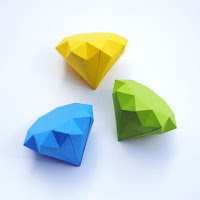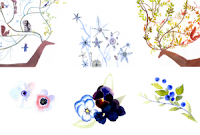Necklaces are believed to be as old as 40,000 years, during the Stone Age. The oldest necklaces were made of purely natural materials - before weaving and the invention of string, durable vines or pieces of animal sinew left over from hunts were tied together and adorned with shells, bones or teeth or colourful skins of human prey animals, bird feathers, corals, carved pieces of wood, colorful seeds or stones or naturally occurring gems, or other beautiful or artful natural elements found nearby.
#jewelleryfacts365 256/365 Gem fact
Thursday, October 13, 2016
Originally, rhinestones were rock crystals gathered from the river Rhine, hence the name, although some were also found in areas like the Alps. The availability was greatly increased in the 18th century when the Alsatian jeweller Georg Friedrich Strass had the idea to imitate diamonds by coating the lower side of glass with metal powder. Hence, rhinestones are called strass in many European languages.
Labels:
gem facts,
jewellery facts
#jewelleryfacts365 255/365
Prior to the introduction of plastics, ivory had many ornamental and practical uses, mainly because of the white color it presents when processed. It was formerly used to make cutlery handles, billiard balls, piano keys, Scottish bagpipes, buttons and a wide range of ornamental items.
Synthetic substitutes for ivory in the use of most of these items have been developed since 1800: the billiard industry challenged inventors to come up with an alternative material that could be manufactured; the piano industry abandoned ivory as a key covering material in the 1970s.
 |
| Vintage Scottish ivory bagpipes |
Labels:
jewellery facts
#jewelleryfacts365 254/365 Gem fact
The first archaeological evidence known of usage of the obsidian were made from within Kariandusi and other sites of the Acheulian age (beginning 1.5 million years previously) dated 700,000 BC
Labels:
gem facts,
jewellery facts
#jewelleryfacts365 253/365 Gem facts
Monday, October 10, 2016
Being a phosphate mineral, turquoise is inherently fragile and sensitive to solvents; perfume and other cosmetics will attack the finish and may alter the colour of turquoise gems, as will skin oils, as will most commercial jewellery cleaning fluids. Prolonged exposure to direct sunlight may also discolour or dehydrate turquoise. Care should therefore be taken when wearing turquoise jewellery. Cosmetics, including sunscreen and hair spray, should be applied before putting on a turquoise piece of jewellery. Also, you should not wear it to a beach or other sun-bathed environment. After use, turquoise should be gently cleaned with a soft cloth to avoid a buildup of residue, and should be stored in its own container to avoid scratching by harder gems. Turquoise can also be adversely affected if stored in an airtight container.
 |
| Silver ring with turquoise and sugilite |
Labels:
gem facts,
jewellery facts
#jewelleryfacts365 252/365 Diamond fact
In the time of the Pharaohs, 3000BC, a diamond was placed in the middle of the ankh – a cross with a loop on top. This was the Egyptian hieroglyph meaning life. Diamonds represented the sun, symbol of power, courage and truth.
Labels:
Ancient Egypt facts,
diamond facts,
jewellery facts
#jewelleryfacts365 251/365 Diamond fact
Only one in a million of mined diamonds ends up in jewelry.
Labels:
diamond facts,
jewellery facts
Jewellery masterpieces
Friday, October 7, 2016
 |
| Henri Vever | Opal and Diamond Pendant c1910. |
Labels:
Jewellery masterpieces
#jewelleryfacts 250/365
Chinese used diamonds and sapphires to polish ceremonial burial axes as early as 6,000 years ago. The axes, which are made from corundum (or ruby in its red form and sapphire in other colors), were polished to a mirror finish.
 |
| Diamond-polished corundum axe from the Neolithic Liangzhu culture of ancient China, ca. 2500 B.C. Photo by Peter J. Lu |
Labels:
diamond facts,
jewellery facts,
ruby facts,
sapphire facts
#jewelleryfacts365 249/365 Diamond fact
Thursday, October 6, 2016
The Hindus, who were known to use diamonds in the eyes of their statues, believed that diamonds were created when bolts of lightning struck rocks. Diamonds were also believed to attract lightning bolts.
Labels:
diamond facts,
jewellery facts
#jewelleryfacts365 248/365 Diamond fact
While diamonds are one of the hardest substances in nature (although recent research has proved otherwise), synthetic nanomaterials have been created that are much harder.
Labels:
diamond facts,
jewellery facts
#jewelleryfacts365 247/365
Some of the world's most famous diamonds, including the Hope Diamond, have been set in platinum.
 |
| Delicate by royal standards, the Pendant Brooch is home to two Cullinan diamonds, namely the emerald cut Cullinan VI and elegant marquise cut Cullinan VIII. |
Labels:
diamond facts,
jewellery facts,
platinum facts
#jewelleryfacts365 246/365
The ancient Egyptians, Central Americans and the Chinese also buried jade with their dead, usually in the mouth. Green stones were most often used, they were meant to represent the heart.
Labels:
Ancient Egypt facts,
jewellery facts
#jewelleryfacts365 245/365
Most commonly still worn today is the Irish Claddagh ring, two hands holding a heart with a crown. The Claddagh ring was first designed in the 16th century, 13 centuries after the original fede rings of Rome.
Labels:
jewellery facts
Bead Day
Saturday, October 1, 2016
 |
| Plateau artist, Vest, ca. 1920, glass beads on hide, The Elizabeth Cole Butler Collection, no known copyright restrictions |
Labels:
Bead Day
#jewelleryfacts365 244/365
Glass beads have been in use for almost five centuries in the Americas.
Labels:
jewellery facts
#jewelleryfacts365 243/365
Friday, September 30, 2016
Throughout history while the ideas of marriage changed along with the styles of the rings that represented it, the ring finger also changed. Weddings rings have been documented to be worn on every finger, even the thumb.
Labels:
jewellery facts
#jewelleryfacts365 242/365
Thursday, September 29, 2016
Virtually all of the Inkas' golden treasure was melted down, first in a vain attempt to ransom their captured king. Then, after his execution, more gold was commandeered to fill the coffers of the Spanish treasury.
Labels:
jewellery facts
#jewelleryfacts365 241/365 Copper fact
In 1939, the German physician, Werner Hangarter, noticed that Finnish copper miners were unaffected by arthritis as long as they worked in the mining industry. (source)
Labels:
copper fact,
jewellery facts
#jewelleryfacts365 240/365 Gem fact
Benitoite is an unusual mineral found only in the southern part of the Mount Diablo range near the San Benito-Fresno border in California. Because of its similarity in color, it was initially thought to be sapphire. Benitoite is unique in that it crystallizes in a class of the hexagonal system which has a trigonal axis of symmetry. Large stones are unheard of and this stone is not only rare, but also quite attractive. Prices for 1ct. stones could easily exceed prices for almost any diamonds in a similar weight range.
 |
| Benitoite |
Labels:
gem facts,
jewellery facts
#jewelleryfacts365 239/365 Gem fact
Bixbite is the red variety of Beryl, and is classified in the same family as Emerald. This very rare gemstone was mined only at the Wah Wah Mountains deposit in Utah and this deposit is finished for now. The last operators had to totally restore the site when they passed on their option. Anyone wishing to go back and re-open the mine will spend millions just removing the overburden. There may still be red beryl in the ground but it hasn't proven to be economical to pull it out. The largest stones in the world are less than 3cts. in weight and there is zero new production. A fine top color bixbite, even a slightly included one could fetch prices exceeding even the best 1ct. sized diamonds.
 |
| Bixbite |
Labels:
gem facts,
jewellery facts
#jewelleryfacts365 238/365
Some suggest that since Neanderthal times gifts were exchanged as tokens of a special relationship. However the origin of an actual ring being given as a token of love appears to date back to Ancient Egypt, about 5000 years ago. We know this through archaeological evidence which found hieroglyphics depicting wedding bands.
The Egyptian grooms would take plant stems from reeds and rushes, and they’d twist and plait them into rings and bracelets which would then be presented to their brides.
It is believed the Egyptians considered the circular shape a symbol of ever-lasting love and good omens, as it is also the shape of the holy Sun and the Moon.
The hole in the centre of the ring was symbolic of the unknown things to come in their new life as a married couple.
Like many of us today, the Egyptians wore their wedding ring on the 4th finger of the left hand. The origin of this custom is from the belief that there was a vein running from this ring finger, all the way to the heart. So by wearing a ring on this finger you are saying that the person who gave you that ring has a direct link to your heart.
(source)
Labels:
jewellery facts
Bead Day
Saturday, September 24, 2016
 |
| TUTORIAL by Mikki Ferrugiaro Carousel Too Rolled Edge Peyote Bangles |
Labels:
Bead Day
#jewelleryfacts365 237/365 Silver fact
In the 15th century a gift of jewelry was often sent from the father of the bride to father of the groom, proposing the intent to marry off his daughter.
 |
| Silver ring |
Labels:
jewellery facts
#jewelleryfacts365 236/365 Silver fact
Hippocrates wrote that silver had beneficial healing and anti disease properties. The expression 'born with a silver spoon in their mouth' stems from health rather than wealth status, as children fed with silver utensils were believed to be healthier.
 |
| Antique Victorian Silver Leaf Caddy Spoon with Grape and Vine Pattern |
Labels:
jewellery facts,
silver facts
#jewelleryfacts365 235/365 Silver fact
Thursday, September 22, 2016
There are impurities that naturally occur in silver at the molecular level. These impurities consist of other metals - usually copper, but traces of other metals can also be found. These trace impurities are insignificant, and would be too costly to remove - so .999 silver is considered pure.
Labels:
jewellery facts,
silver facts
#jewelleryfacts365 234/365 Gem fact
The most common species of tourmaline is schorl, (brownish or black in colour). It may account for 95% or more of all tourmaline in nature.
 |
| Black tourmaline |
Labels:
gem facts,
jewellery facts
#jewelleryfacts365 233/365 Gem fact
In 1593, Friar De Nica travelled in New Mexico and noted that “the people have emeralds and other jewels, although they esteem none so much as turquoises, wherewith they adorn the wall of the porches of their houses and apparel and vessels, and they use them instead of money through all the country.”
 |
| Blue turquoise cocktail ring, sterling silver |
Labels:
gem facts,
jewellery facts
#jewelleryfacts365 232/365 Sapphire fact
A rare variety of sapphire, known as color changing sapphire, exhibits different colors in different light. A color change sapphire is blue in natural light, and violet in artificial light.
 |
| Owl ring with sapphire eye |
Labels:
jewellery facts,
sapphire facts
#jewelleryfacts365 231/365
A species of hard nut is gaining popularity as a replacement for ivory, although its size limits its usability. It is sometimes called vegetable ivory, or tagua, and is the seed endosperm of the ivory nut palm commonly found in coastal rainforests of Ecuador, Peru and Colombia.
 |
| Tagua carvings |
Labels:
jewellery facts
#jewelleryfacts365 230/365
Both the Greek and Roman civilizations practiced ivory carving to make large quantities of high value works of art, precious religious objects, and decorative boxes for costly objects. Ivory was often used to form the white of the eyes of statues.
 |
| The Byzantine Barberini Ivory from the 6th Century AD has been attributed to a royal workshop in Constantinople. |
Labels:
jewellery facts
Jewellery masterpieces
Friday, September 16, 2016
 |
| Enamel. Marcus Synnot |
Labels:
Jewellery masterpieces
#jewelleryfacts365 228/365 Gem fact
Thursday, September 15, 2016
Jade has been known to Man for some 7000 years. In prehistoric times, however, it was esteemed rather more for its toughness, which made it an ideal material for weapons and tools.
 |
| Jade rock from Alaska |
Labels:
gem facts,
jewellery facts
#jewelleryfacts365 227/365 Gem fact
The most common imitation of turquoise encountered today is dyed howlite and magnesite, both white in their natural states, and the former also having natural (and convincing) black veining similar to that of turquoise. Dyed chalcedony, jasper, and marble is less common, and much less convincing.
 |
| Dragonfly necklace (copper, sterling silver, natural turquoise, blue topaz) |
Labels:
gem facts
Jewellery masterpieces
Tuesday, September 13, 2016
 |
| AN ART NOUVEAU ENAMEL AND DIAMOND BRACELET |
Labels:
Jewellery masterpieces
#jewelleryfacts365 226/365 Gem fact
Tanzanite forms as a brownish crystal and is trichroic - which means it shows three colors - brown, blue and violet concurrently. Heating - either occurring underground naturally by metamorphic occurrences or above ground by man in a furnace removes the brown or burgundy color component to produce a stronger purplish-blue color and makes the stone "dichroic" which means it only reflects blue and violet. (source) Some stones found close to the surface in the early days of the discovery (in an area now called D block) were gem-quality blue without the need for heat treatment - probably the result of a wild fire in the area which heated the stones underground.
 |
| Tanzanite |
Labels:
gem facts,
jewellery facts
#jewelleryfacts365 225/365 Pearl fact
The Greeks explained the origins of pearls in their mythology. To them pearls were tears of joy that Aphrodite, the Goddess of Love, shed when she was born from sea froth.
 |
| Aphrodite earrings |
Labels:
jewellery facts,
pearl facts
#jewelleryfacts365 224/365 Copper fact
The first recorded medical use of copper is found in the Smith Papyrus, one of the oldest books known. The Papyrus is an Egyptian medical text, written between 2600 and 2200 B.C., which records the use of copper to sterilize chest wounds and to sterilize drinking water. (source)
Labels:
copper fact,
jewellery facts
#jewelleryfacts365 223/365
It is estimated that ivory consumption in Great Britain alone in 1831 amounted to the deaths of nearly 4,000 elephants.
 |
| Elephant tusks |
Labels:
jewellery facts
Jewellery masterpieces
Friday, September 9, 2016
 |
| Renaissance Revival 18kt Gold Gem-set Armlet, c. 1880, bezel-set with sapphire and diamond florets, bezel-set sapphire, emerald, and ruby accents, rose-cut diamond highlights. |
Labels:
Jewellery masterpieces
#jewelleryfacts365 222/365 Gem fact
Amber is fossilized tree resin (not sap), which has been appreciated for its color and natural beauty since Neolithic times.
 |
| Vilnius’ Amber Museum |
Labels:
gem facts,
jewellery facts
Subscribe to:
Posts (Atom)























































